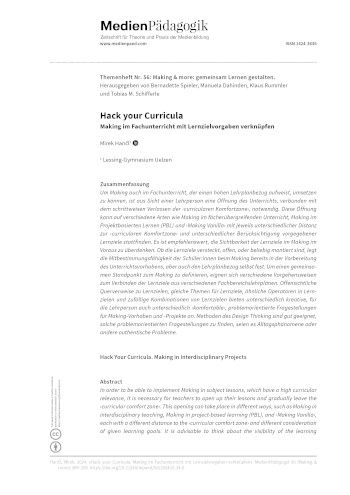Abstract
In order to be able to implement Making in subject lessons, which have a high curricular relevance, it is necessary for teachers to open up their lessons and gradually leave the ‹curricular comfort zone›. This opening can take place in different ways, such as Making in interdisciplinary teaching, Making in project-based learning (PBL), and ‹Making Vanilla›, each with a different distance to the ‹curricular comfort zone› and different consideration of given learning goals. It is advisable to think about the visibility of the learning objectives in Making activities in advance. Whether the learning objectives are hidden, open, or arbitrarily mounted, determines the co-determination of the students in Making already in the preparation of the project. To define a position on cross-curricular Making, different approaches to linking learning objectives from different subject area curricula are suitable. Obvious cross-references to learning objectives, same topics for learning objectives, similar operators in learning objectives, and random combinations of learning objectives offer differently creative, and for the teacher also differently ‹comfortable›, problem-oriented questions for Making activities. Design Thinking methods are well suited to find authentic, problem-oriented questions.
References
Blikstein, Paulo. 2013. «Digital Fabrication and ‹Making› in Education: The Democratization of Invention.» In FabLabs: Of Machines, Makers and Inventors, herausgegeben von Julia Walter-Herrmann und Corinne Büching, 203–22. Bielefeld: transcript.
Clapp, Edward P., Jessica Ross, Jennifer O. Ryan, und Shari Tishman. 2016. Maker-centered Learning: Empowering Young People to Shape Their Worlds. Hoboken, NJ: John Wiley & Sons.
COCD. 2022. «COCD-box.». https://schoolofcreativethinking.nl/articles/cocd-box/.
Condliffe, Barbara, Janet Quint, Mary G. Visher, Michael R. Bangser, Sonia Drohojowska, Larissa Saco, und Elizabeth Nelson. 2017. «Project-Based Learning: A Literature Review». MDRC (New York). https://eric.ed.gov/?id=ED578933.
D-EDK, Hrsg. 2016. «Lehrplan 21. Gesamtausgabe.» Deutschschweizer Erziehungsdirektoren-Konferenz. https://v-fe.lehrplan.ch/container/V_FE_DE_Gesamtausgabe.pdf.
Domke, Johannes. 2022. «Warum wird Software in unveränderter Form ‹Vanilla› genannt?». https://www.sir-apfelot.de/warum-heisst-es-vanilla-software-41462/.
DWDS. 2021. «Artefakt» In Digitales Wörterbuch der deutschen Sprache. Berlin-Brandenburgische Akademie der Wissenschaften. https://www.dwds.de/wb/Artefakt.
Feldhaus, Lea, Julia Primavera, und Anna Kleibl. 2018. Design Thinking und Schule – Das Handbuch für den Schulalltag. Weinheim: HOPP Foundation for Computer Literacy & Informatics gGmbH.
Häusslein, Gepa. 2023. «Design Thinking in der Schule». Pädagogik 4: 34–38. https://doi.org/10.3262/PAED2304034.
IDF. o. J. «Worst Possible Idea». Interaction Design Foundation. https://www.interaction-design.org/literature/topics/worst-possible-idea.
Labudde, Peter. 2004. «Fächer übergreifender Unterricht in Naturwissenschaften: ‹Bausteine› für die Aus- und Weiterbildung von Lehrpersonen». Beiträge zur Lehrerbildung 22 (1): 54–68. https://doi.org/10.25656/01:13539.
Markula, Anette, und Maija Aksela. 2022. «The key characteristics of project-based learning: how teachers implement projects in K-12 science education». Disciplinary and Interdisciplinary Science Education Research 4 (1). https://doi.org/10.1186/s43031-021-00042-x.
Merriam-Webster. 2023. «Stichwort ‹Vanilla›». Merriam-Webster.com Dictionary. https://www.merriam-webster.com/dictionary/vanilla.
Murrell-Harvey, Cecilia. 2021. «Vanilla». In The Lexiculture Papers: English Words and Culture, herausgegeben von Stephen Chrisomalis, 321–24. Wayne State University. https://digitalcommons.wayne.edu/anthrofrp/4/.
OMG. 2017. «OMG Unified Modeling Language (OMG UML)», Version 2.5.1: Object Management Group. https://www.omg.org/spec/UML/2.5.1/PDF.
Peschel, Falko. 2002. «Qualitätsmassstäbe – Hilfen zur Beurteilung der Offenheit von Unterricht.» In Freiarbeit in der Grundschule. offener Unterricht in Theorie, Forschung und Praxis, In Beiträge zur Reform der Grundschule, 160–71. Frankfurt a. M.: Grundschulverband – Arbeitskreis Grundschule e.V. https://doi.org/10.25656/01:17637.
SessionLab. o. J. «How-Now-Wow Matrix». https://www.sessionlab.com/methods/how-now-wow-matrix.
Wilkins, Robert P. 1984. «PC Buyerʼs Guide for Lawyers». PC Mag, 297–8.

